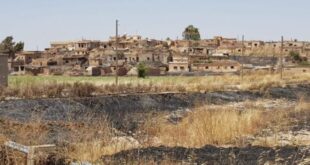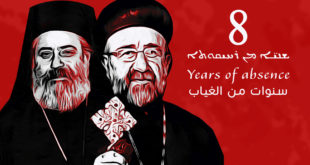MA’LULA, Syria (ADO-World.org) – Ma’lula, this charming famous village in Syria, is some 56 kilometers, less than one hour’s drive, north from Damascus on the main road between Damascus and Aleppo, and is situated at an altitude of more than 1,500 meters, inhabited by 5,000 people, both Christians and Muslims.
There are two monasteries here: Saint Sergius and Saint Taqla’s. The inhabitants still speak Aramaic, the language spoken by Christ. Two neighboring villages, Jaba’din and Naj’a, also speak the same language. The word Ma’lula means "entrance" in Aramaic.
My trip to Ma’lula came after attending Arabian Tourism Borsa in Damascus during November 2010. The guide, as well as guests from Indonesia and other countries, made our trip a nice one. We were able to speak with many citizens in Maaloula, and they are really nice people who believe that tourists and guests visiting them are brothers and friends.
Here in Maa’lula, you can see the people satisfied with the nature and with the treasures that their region have; here, you can feel the history as you listen to the Aramic language.
Ma’lula is a major tourist attraction in Syria. Hundreds of tourists were enjoying the area when we visited the village. All services can be found in Ma’lula from big restaurants to shops and good transportation.
Mosques peacefully exist alongside churches, where you can hear the sound from both at the same time, making for a very special and unique experience.
I believe Ma’lula is a must-visit place in Syria. It is a place whose images can explain the beauty this village more than words ever could.
The ancient Greeks were probably the first to call the Aramean population Syrians; the name “Aram” was first mentioned around 2300 BC. Many Aramaic tribes developed into special ethnic groups and gained names of their own such as the Canaanites in Palestine, the Palmyreans in Syria, the Nabataens in Jordan, the Chaldeans in Iraq, and so forth. The Aramaic language in its various dialects has been spoken for thousands of years by the people living between the eastern coasts of the Mediterranean and Mesopotamia. It was the mother tongue of Jesus Christ and the Holy Bible was originally written in old Aramaic.
The most important monument in the town is the Convent of Our Lady of Saidnaya. From a distance it looks like a fortress, perched on a rocky hillock in the town center. The convent that hosts a school, monastery for nuns, and an orphanage is a famous pilgrimage site for Christians and Muslims alike. The object of adoration is an icon of the Virgin Mary supposedly painted by Saint Luke located in a small dark shrine-like room. The main chapel has an antique wooden iconostasis and numerous gold-painted icons. The convent was founded by the Byzantine Emperor Justinian in the sixth century.
Among the houses of the town there are several small churches, monasteries, and shrines dedicated to various saints. Many of them are very old but have undergone comprehensive restoration. Around the town there are two religious sites worth visiting: the Monastery of Mar Thomas and the Cherubim Convent, situated strategically on the highest point of the local mountain range.
Moderrn Aramaic (Syriac) is still widely spoken in the town. The caves around the town suggest that it was a pre-historic settlement and one of the earliest centers of Christianity. The most important tourist attraction is the defile of Saint Thecla. According to legend, Thecla was the daughter of a prince who converted to Christianity and ran to hide in Maaloula. Her father sent soldiers to execute her for her conversion to the new faith. Finding herself trapped against the cliffs, she prayed to God for help. Her prayers were answered and a narrow path (the defile, or gap between two mountains which we see today) opened in the rocky mountains, allowing her to escape to a little cave up in the cliffs. The Convent of Mar Thecla that hosts the holy shrine of Saint Thecla is a very popular pilgrimage site for Christians from all over the Arab Middle East. The Convent of Our Lady of Saidnaya and the Convent of Saint Thecla belong to the Greek Orthodox Patriarchy of Damascus, one of the oldest Christian communities worldwide (established in the fourth century AD).
Maaloula is famous for the traditional and authentic architecture in the old part of the town. Many old buildings, especially the churches and shrines, have been extensively restored. Both towns are highly frequented by local, Arab, and international tourists. Both are included in package tours and are a must for individual tourists. The rich history and the religious exclusiveness, as well as the gorgeous geographic location and the hospitality of the people, make the two towns one of the most unforgettable sites in Syria. They are evidence of the religious and cultural richness of modern Syrian society and are an irreplaceable landmark of human civilization.
By Motaz Othman
Source: eTurboNews
 Assyrian Democratic Organization ADO
Assyrian Democratic Organization ADO






